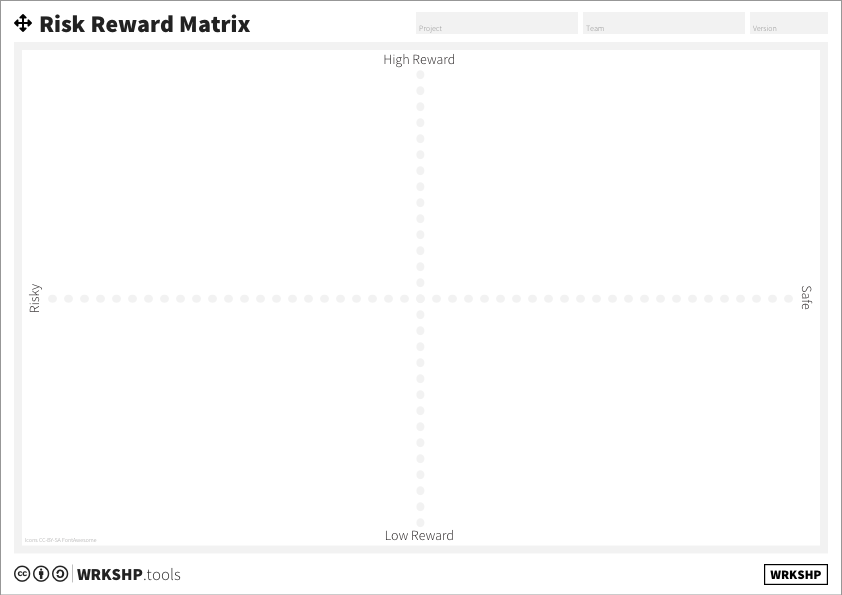Risk Reward Matrix
The Risk Reward Matrix helps you to balance Risk and Reward when choosing among options.
Use this tool when:
- you want to choose among different ideas based on how risky or rewarding they may be
Overview
| Time | ± 45 minutes | |
| Difficulty | 3 / 5 | |
| People | 3 - 5 | |
| Author | erik van der pluijm | |
| Website | ||
| License | CC BY SA 4.0 |

What is it and when should I use it?
When ideating, and coming up with different options, you often end up with a long list of ideas. How to choose the ones to work on?
One way is to look at the impact vs uncertainty these ideas might have on your business (see Uncertainty Matrix). But another, highly effective way is to look at how risky vs rewarding the ideas or directions might be.
The Risk Reward Matrix helps you map ideas, strategies, and directions, allowing you to make more informed decisions.
Tool Overview

Risky Things that involve a high risk.
Safe Things that can't really go wrong.
High reward Things that will bring in a high reward.
Low reward Things that won't bring much of a reward.
Steps
1 Collect
The first step is to collect the things you want to map. The Risk Reward Matrix is a great tool to choose among various options or possible directions, for instance, different business models to explore, different sales strategies to follow, or different experiments to run.
Get a list of ±10-20 items, and make sure you label each clearly on a post-it note.
2 Map Reward
First, for each of the post-its you wrote, map them only on the 'reward' axis. It is usually easier to gauge the reward. Have team members pick each post-it, and place it on the vertical central line where they think it should go.
Tip! Have the person that places the post-it explain what it is and why they are placing it there.
Tip! When you're done, step back and see if the items are ordered correctly in terms of relative rewards. That means, an item should be less rewarding than all items above it, and more rewarding than all items below it.
3 Map Risk
Next, have the team silently reshuffle the post-its on the horizontal axis. They can move post-its left and right, reflecting how risky they think achieving them is. If you don't agree on the horizontal position, choose the left-most one (the most risky), as your disagreement reflects that risk. EXAMPLE Think of risk as the probability of failure, and the impact of that failure. An experiment by itself may have a risk of failure, but it becomes high risk when it can backfire and the people in the experiment start complaining about your company on social media.
Example Think of risk as the probability of failure, and the impact of that failure. An experiment by itself may have a risk of failure, but it becomes high risk when it can backfire and the people in the experiment start complaining about your company on social media.
Tip! When you're done, step back and see if the items are ordered correctly in terms of relative risks. That means, an item should be less risky than all items to the right of it, and more risky than all items to the left of it.
4 Find low-hanging fruit
There are in essence 5 big groups that each post-it can end up in. Look at the checklist below, and find the post-its that are low-hanging fruit or that are high-risk. Use that to inform your choice.
- Top left: High risk, high reward. If you can find a way to de-risk these, they might give you a competitive advantage.
- Top right: Low risk, high reward. This is 'low-hanging fruit' that you can work on right away.
- Bottom left: High risk, low reward. The Danger Zone. These are things that you should stay away from.
- Bottom right: Low risk, low reward. These are things you should automate, reduce, or otherwise stop doing – unless you can find a way to raise their reward level.
- Center: Post-its in the center are middle of the road, and probably not that interesting
5 Next Steps
Use the result to inform your next decisions.